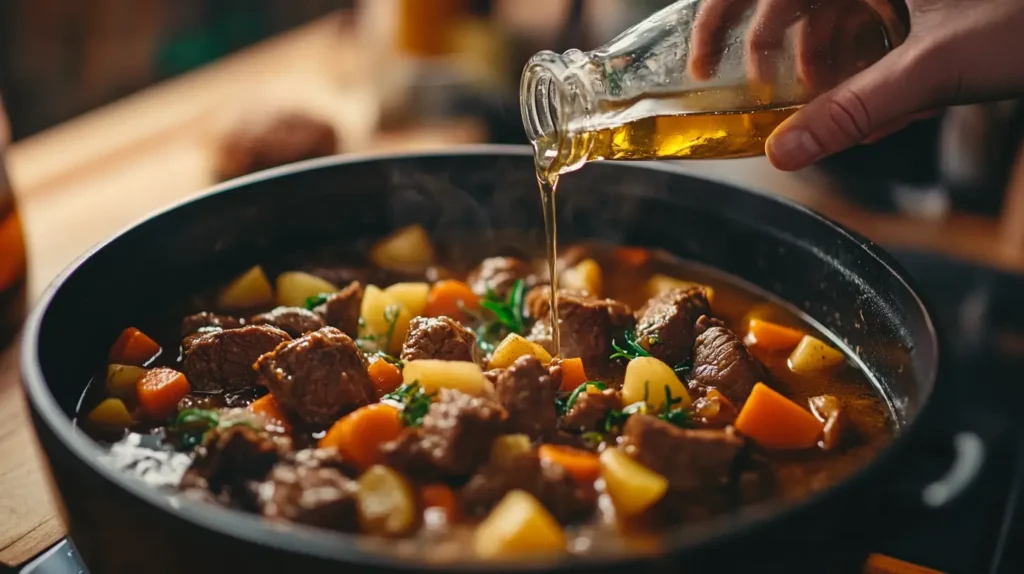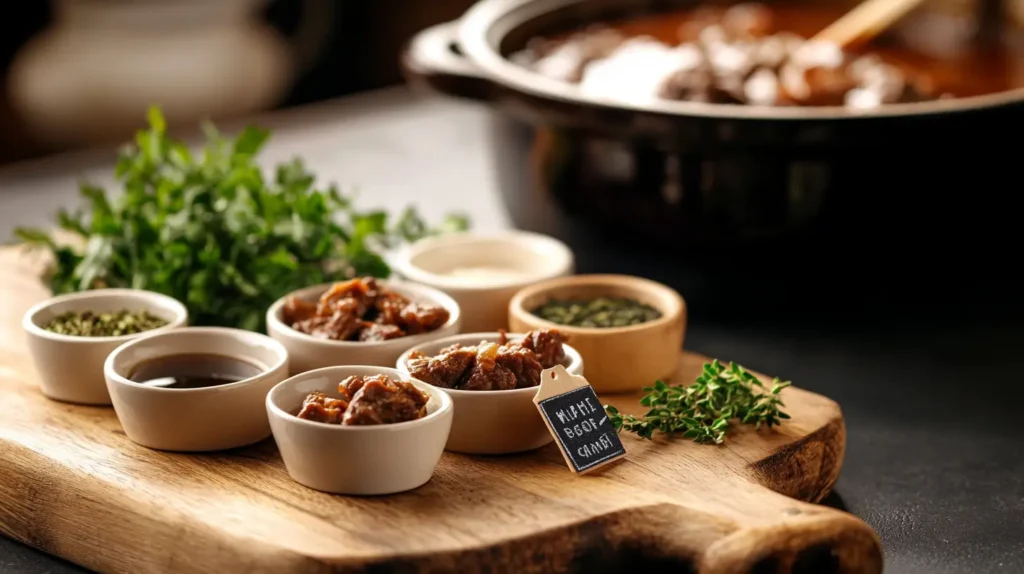Beef stew is a comforting, hearty dish cherished in kitchens around the world for generations. Its rich, savory flavors come from the careful combination of tender beef, vegetables, and aromatic spices, simmered together to create a deeply satisfying meal. But why add vinegar to beef stew? This simple yet transformative ingredient can elevate your stew to the next level, enhancing flavor, tenderizing meat, and balancing its richness.

Adding vinegar to beef stew is a culinary technique that can enhance the dish in multiple ways. From balancing flavors to tenderizing the meat, this versatile ingredient has the potential to turn an ordinary stew into an extraordinary one. In this article, we’ll explore the reasons why vinegar is an essential addition to beef stew, how it works, and the best types of vinegar to use for the most delicious results.
Table of Contents
The Science Behind Vinegar
Vinegar is much more than a simple pantry staple; it’s a fascinating ingredient with unique chemical properties that can transform a dish like beef stew. At its core, vinegar is an acidic liquid created through fermentation, typically containing acetic acid along with trace compounds that contribute to its flavor and aroma. Its acidic nature plays a pivotal role in cooking, particularly in recipes that involve long, slow cooking processes, such as stews.
1. Tenderizing Meat
One of vinegar’s most notable effects in beef stew is its ability to tenderize the meat. The acetic acid in vinegar in beef stew breaks down tough connective tissues in beef, making it more tender and easier to chew. When incorporated into a marinade or added during cooking, vinegar penetrates the meat fibers, ensuring a melt-in-your-mouth texture.
2. Balancing Flavors
Vinegar adds a subtle tanginess to beef stew that brightens and balances the dish’s overall flavor. The acidity cuts through the richness of the meat and the savory broth, preventing the stew from becoming overly heavy. This balance is essential for creating a complex and harmonious flavor profile.
3. Enhancing Aromatics
The acidity in vinegar in beef stew can also enhance the release of aromatic compounds in spices and vegetables, amplifying their impact on the stew. This means that a splash of vinegar can make the garlic, onions, and herbs in your stew even more flavorful and aromatic.
4. Improving Browning Reactions
While vinegar is not directly involved in the Maillard reaction (the browning of proteins and sugars), its acidity can influence the environment in which this reaction occurs. A slight adjustment in pH due to the addition of vinegar may help achieve deeper, more flavorful browning when searing the beef, ultimately enriching the stew’s depth of flavor.
5. Preserving Nutrients
Interestingly, the acidity of vinegar can help preserve certain nutrients in vegetables during the cooking process. By stabilizing the cellular structure, vinegar minimizes the breakdown of vitamins and minerals, ensuring your stew remains nutritious as well as delicious.
In summary, the science behind vinegar in beef stew explains why this ingredient is a valuable addition to beef stew. From tenderizing the meat to balancing flavors and amplifying aromatics, vinegar works on multiple levels to create a well-rounded and deeply satisfying dish.
What Is Vinegar?
vinegar in beef stew is a liquid condiment created through the fermentation of ethanol by acetic acid bacteria. Its primary component, acetic acid, gives vinegar its characteristic tangy flavor and sharp aroma. While vinegar can be made from a variety of base ingredients, including grapes, apples, and grains, the fermentation process is what transforms these natural sources into the versatile ingredient we know today. Depending on its origin and production method, vinegar can exhibit a wide range of flavors, from mild and fruity to robust and pungent.
Acidity and Flavor Interaction
Acidity is the defining characteristic of vinegar in beef stew, and it plays a crucial role in enhancing the flavors of a dish. In beef stew, the acidity interacts with the dish’s rich and savory components, cutting through the heaviness and providing a fresh, vibrant contrast. This interplay of flavors creates a more balanced and enjoyable eating experience. Additionally, the tangy notes of vinegar can highlight subtle flavors in herbs, spices, and vegetables, ensuring that no single ingredient overpowers the dish.
Types of Vinegar Best for Beef Stew
Choosing the right vinegar in beef stew for your beef stew is essential to achieve the desired flavor profile. Here are some of the best types to consider:
- Red Wine Vinegar
Red wine vinegar is a classic choice for beef stew. Its deep, robust flavor complements the richness of the beef and enhances the overall depth of the dish. It also pairs well with hearty vegetables like carrots, potatoes, and onions. - Balsamic Vinegar
For a touch of sweetness and complexity, balsamic vinegar in beef stew is an excellent option. Its syrupy texture and rich flavor can add a layer of sophistication to your stew, making it ideal for more gourmet recipes. - Apple Cider Vinegar
Apple cider vinegar brings a mild tanginess and fruity undertones that brighten the dish without overpowering other flavors. It’s a versatile choice that works well in a variety of beef stew recipes. - White Wine Vinegar
For a lighter, more delicate flavor, white wine vinegar is a good alternative. It’s less robust than red wine vinegar but still provides the acidity needed to balance the stew. - Malt Vinegar
If you prefer a slightly nutty and toasty flavor, malt vinegar in beef stew is worth trying. Its earthy notes pair wonderfully with slow-cooked beef and root vegetables. - Sherry Vinegar
Sherry vinegar offers a complex and slightly nutty flavor, making it a sophisticated addition to beef stew. Its subtle sweetness can round out the dish beautifully.
When selecting vinegar for beef stew, consider the flavor profile you want to achieve. Experimenting with different types can lead to exciting variations and a stew that perfectly suits your taste.

How to Use Vinegar in Beef Stew
Incorporating vinegar in beef stew into your beef stew is a straightforward process, but understanding how to use it effectively can make a significant difference in the outcome. From selecting the right vinegar to determining the perfect timing and quantity, here’s everything you need to know.
Choosing the Right Type of Vinegar
The type of vinegar in beef stew you use will greatly influence the flavor of your stew. Here are some guidelines to help you choose:
- Red Wine Vinegar: Ideal for a classic, rich beef stew, adding depth and complexity.
- Apple Cider Vinegar: Provides a subtle tang with fruity undertones, perfect for lighter stews.
- Balsamic Vinegar: Brings sweetness and a luxurious depth, ideal for gourmet recipes.
- White Wine Vinegar: Offers a lighter, more delicate acidity.
- Sherry Vinegar: Adds nuttiness and subtle sweetness for a sophisticated touch.
Choose a vinegar in beef stew that complements the overall flavor profile of your stew and pairs well with the other ingredients.
How Much Vinegar to Use
The amount of vinegar you use depends on the recipe, your personal taste preferences, and the type of vinegar. As a general guideline:
- Start with 1 to 2 tablespoons of vinegar in beef stew for a standard-sized stew recipe (serving 4–6 people).
- Adjust to taste, adding small amounts incrementally to avoid overpowering the dish.
- If using a stronger vinegar, such as balsamic, start with a smaller quantity to prevent the stew from becoming too sweet or tangy.
When to Add Vinegar
Timing is crucial when adding vinegar to your beef stew. Here are some common approaches:
- At the Beginning: Add vinegar in beef stew during the initial cooking stages to tenderize the meat and allow the flavors to meld as the stew simmers.
- Midway Through Cooking: Adding vinegar halfway allows it to enhance the flavor while maintaining its brightness.
- At the End: For a tangier, more pronounced flavor, add vinegar in the final stages of cooking or as a finishing touch before serving.
Experiment to find the timing that best suits your desired flavor and texture.
Enhancing Stew with Other Ingredients
Vinegar works synergistically with other ingredients to enhance your beef stew. Consider pairing it with:
- Sugar or Honey: To balance the tanginess of vinegar in beef stew with a touch of sweetness.
- Tomato Paste or Diced Tomatoes: For a deeper umami flavor and added acidity.
- Fresh Herbs: Such as thyme, rosemary, or parsley, to elevate the stew’s aromatic profile.
- Garlic and Onions: These aromatics pair beautifully with the acidity of vinegar to create a rich, savory base.
Using complementary ingredients helps achieve a well-rounded flavor profile.
Common Mistakes to Avoid
Avoid these pitfalls to ensure the best results when using vinegar in your beef stew:
- Using Too Much Vinegar: Overpowering the dish with excessive vinegar in beef stew can make it too tangy or acidic. Always add gradually and taste as you go.
- Skipping Adjustments: Failing to balance the acidity with sweetness or richness can result in a one-dimensional flavor.
- Adding Vinegar Too Late: While adding vinegar at the end can enhance tanginess, doing so without simmering may result in an overly sharp taste.
- Choosing the Wrong Type of Vinegar: The wrong vinegar in beef stew can clash with the other flavors in the stew, so pick one that complements the dish.
By following these tips and techniques, you can master the art of using vinegar in beef stew, creating a dish that is flavorful, tender, and perfectly balanced.
Alternative Ingredients to Vinegar
If you don’t have vinegar in beef stew on hand or prefer to experiment with other flavors, several alternative ingredients can achieve similar effects in your beef stew. These substitutes can provide acidity, depth, or a unique twist to your recipe.

Lemon Juice
Lemon juice is a versatile and readily available substitute for vinegar in beef stew. Its natural acidity brightens the flavors of beef stew while imparting a subtle citrusy aroma. To use lemon juice:
- Add 1–2 tablespoons at the end of cooking for a fresh, tangy flavor.
- Use it sparingly if paired with other strong flavors to avoid overpowering the dish.
Wine
Red or white wine can replace vinegar in beef stew while adding complexity and richness to the stew. The alcohol cooks off during simmering, leaving behind the wine’s nuanced flavors.
- Red Wine: Ideal for hearty stews, contributing robust and earthy undertones.
- White Wine: Perfect for lighter stews, offering a crisp, mild acidity.
- Use ¼ to ½ cup of wine, depending on the recipe, and allow it to reduce during cooking.
Tomato-Based Ingredients
Tomato-based ingredients, such as tomato paste, diced tomatoes, or canned tomato sauce, bring both acidity and umami to the dish. They also add a deep, rich color and enhance the stew’s texture.
- Add 2–3 tablespoons of tomato paste or 1 cup of diced tomatoes early in the cooking process.
- Adjust other seasonings to balance the acidity and sweetness of the tomatoes.
Yogurt or Buttermilk
Yogurt or buttermilk offers a creamy and tangy alternative, particularly in stews with a fusion or Middle Eastern influence. These dairy-based ingredients tenderize meat while contributing a mild sourness.
- Use ¼ to ½ cup of plain yogurt or buttermilk, stirring it in during the final stages of cooking.
- Avoid curdling by tempering the yogurt or adding it at low heat.
Tamarind Paste
Tamarind paste is a bold, tangy option with a unique, slightly sweet flavor. Common in Southeast Asian and Indian cuisines, it can add depth and a hint of exotic flair to your stew.
- Dissolve 1–2 teaspoons of tamarind paste in warm water before adding it to the stew.
- Pair it with complementary spices like cumin, coriander, or turmeric for a cohesive flavor profile.
Pickle Juice
Pickle juice might sound unconventional, but it’s an excellent source of acidity and flavor. Its briny, tangy notes can give beef stew a unique twist, especially in recipes with Eastern European or American influences.
- Add 1–2 tablespoons of pickle juice near the end of cooking.
- Use sparingly to avoid an overly salty or vinegar in beef stew taste.
Adjusting Without Acidic Ingredients
If you prefer to skip acidic ingredients entirely, you can achieve balance using other techniques:
- Sweetness: Add a small amount of honey, sugar, or molasses to counterbalance the richness of the stew.
- Umami Boosters: Incorporate soy sauce, Worcestershire sauce, or miso paste to enhance the savory flavors.
- Fresh Herbs: Brighten the dish with fresh parsley, cilantro, or dill added just before serving.

Experimenting with these alternatives allows you to customize your beef stew to suit your taste and available ingredients, ensuring a delicious and satisfying meal every time.
Frequently Asked Questions
What Kind of Vinegar Works Best?
The best vinegar in beef stew for beef stew depends on the flavor profile you want to achieve:
- Red Wine Vinegar: A classic choice, offering a deep, robust flavor that pairs perfectly with the richness of beef.
- Apple Cider Vinegar: Provides a mild tang with fruity undertones, making it a versatile option.
- Balsamic Vinegar: Adds sweetness and complexity for a gourmet twist.
- Sherry Vinegar: A sophisticated choice with nutty and slightly sweet notes.
- White Wine Vinegar: A lighter, more delicate acidity for milder stews.
Each type of vinegar brings its own character to the dish, so feel free to experiment with different varieties to find your favorite.
Can Vinegar Overpower the Stew?
Yes, vinegar can overpower the stew if used excessively. Its strong acidity can dominate the dish, masking other flavors. To avoid this:
- Start with a small amount, typically 1–2 tablespoons, depending on the recipe.
- Add vinegar gradually, tasting as you go to ensure balance.
- Pair vinegar with complementary ingredients, like a touch of sweetness or umami, to create harmony.
Remember, a little vinegar in beef stew goes a long way in enhancing the dish without overwhelming it.
Is Vinegar Necessary for Beef Stew?
Vinegar is not strictly necessary for beef stew, but it offers several benefits that can elevate the dish:
- Flavor Balance: Adds a tangy brightness that cuts through the richness of the meat and broth.
- Tenderizing Meat: Helps break down tough fibers, making the beef more tender.
- Aromatic Enhancement: Amplifies the flavors of other ingredients, like garlic, onions, and spices.
If you don’t have vinegar in beef stew or prefer not to use it, there are plenty of alternatives, such as lemon juice, wine, or tomato-based ingredients, that can achieve similar effects. Ultimately, the choice to include vinegar depends on your taste preferences and the recipe.
Conclusion: The Secret Ingredient to Perfect Beef Stew
Vinegar is truly the secret ingredient that can transform an ordinary beef stew into an extraordinary culinary masterpiece. Its unique ability to balance flavors, tenderize meat, and enhance the overall complexity of the dish makes it an invaluable addition to any recipe. Whether you choose red wine vinegar in beef stew for its boldness, apple cider vinegar for its subtle tang, or balsamic vinegar for its sweet depth, this humble ingredient has the power to elevate your stew to new heights.
Moreover, vinegar’s versatility allows it to complement a wide range of ingredients, from hearty vegetables to aromatic spices. By understanding how to use vinegar effectively—selecting the right type, adding the right amount, and incorporating it at the optimal time—you can achieve a perfectly balanced and flavorful beef stew every time.
For those who wish to experiment further, there are numerous alternatives to vinegar, such as lemon juice, wine, and tomato-based ingredients, that can offer similar benefits. These options ensure that you can always achieve a delicious stew tailored to your personal taste and preferences.
In the end, the secret to the perfect beef stew lies in striking the right balance of flavors, and vinegar is a simple yet powerful tool to achieve just that. So the next time you’re preparing a comforting pot of beef stew, don’t forget to reach for this secret ingredient and watch your dish transform into something truly unforgettable.
